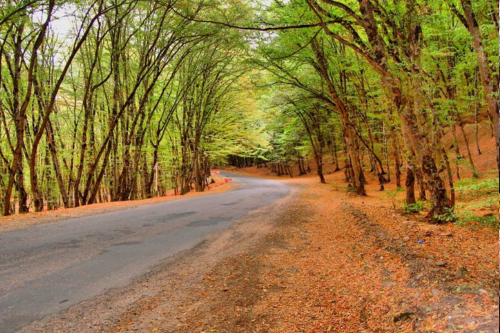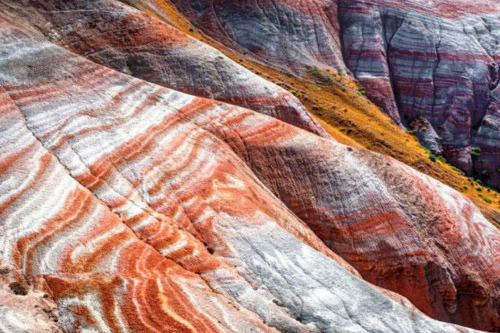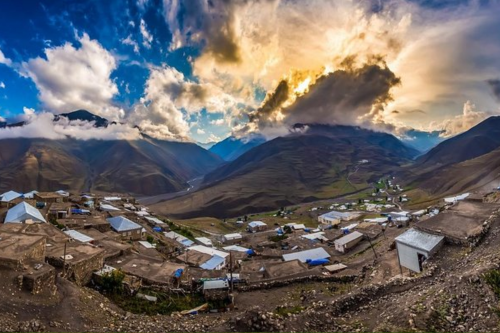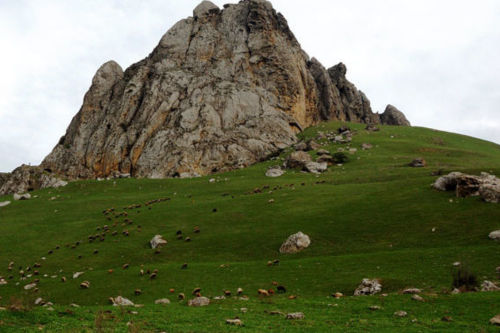Guba-Khinalig tour
$80.00
$40.00





Take a breathtaking trip that winds through ever-changing landscapes and timeless traditions. This route introduces you to the colorful Candy Cane Mountains, the iconic Beshbarmag rock, the historic city of Quba, and the peaceful forest of Gechresh. Continue along the Gudialchay river gorge and finish your day with a visit to Khinalig — one of the oldest highland villages in the world. Every location offers a deeper layer to the story of Azerbaijan — told through its people, its terrain, culture and the silence of its mountains.
The Route
Candy Cane Mountains
The day begins with a stop at one of Azerbaijan’s lesser-known geological treasures — the Candy Cane Mountains, located in the Khizi region. Unlike the rugged peaks of the Caucasus, these softly sloping hills are known for their mesmerizing striations in red, white, and soft pink. The effect is natural, formed by the oxidation of iron and other minerals over millennia, resulting in bands of color that look painted rather than real. The landscape is arid, almost lunar in some places, yet the curves and color gradients bring an unexpected warmth and visual depth.
This site is rarely crowded, and that solitude adds to its quiet allure. It’s a place for photography, for still observation, or even just for pausing to absorb a sense of deep time — the kind of location where the Earth’s history feels written across every surface. As part of this journey, it’s a unique and calming introduction to the natural diversity that lies ahead.
Beshbarmag Mountain
A short distance away stands the towering silhouette of Beshbarmag, meaning “Five Fingers,” named after its dramatic, vertical rock formations that resemble a hand reaching skyward. Rising sharply from the coastal plains near the Caspian Sea, this mountain has long been associated with pilgrimage and spiritual reflection. Small shrines and offerings can be seen near the foot of the rock, where travelers stop briefly for blessings before continuing on their way.
The surrounding terrain is dry and windswept, which enhances the stark presence of the rock itself. The site is often visited not just for its appearance but for the folklore and symbolism connected to it. Local stories speak of warriors, saints, and travelers finding strength or visions on these very slopes. Though climbing to the top is restricted for safety reasons, the mountain’s energy is palpable even from the roadside.
Quba City
The next stop is Quba — a city nestled on the northeastern shoulder of the Greater Caucasus Mountains. It’s a place where heritage is deeply tied to craft, community, and cultivation. Historically a center of carpet weaving, Quba’s reputation for quality textiles continues to thrive, with small workshops still operating in family homes. The city is also famous for its apple orchards, and in autumn the air carries a soft sweetness from the harvest.
Architecturally, Quba is a mix of old and new. Ottoman-era mosques and narrow streets sit beside modern buildings and riverside promenades. One particularly notable site is the arched Kudyalchay Bridge, which spans the river that splits the city and connects it to the unique village of Krasnaya Sloboda — one of the world’s only all-Jewish towns outside of Israel and the US.
Lunch
In Quba we settle for a tasty lunch to take a much needed break from exploring the natural wonders and enjoy some peace and quiet. Usually served in a garden restaurant or forest-side teahouse near the Gechresh region, the setting is simple and natural. Wooden tables, cool breezes, and the sounds of running water or birdsong create a relaxed atmosphere. Meals are freshly prepared, with ingredients sourced from local farms or the forest itself.
A traditional lunch might begin with lavash and soft cheese, followed by rich soups like piti or dushbara. The main course typically features grilled meats such as lamb chops or lula kebab, served with herbed rice, fresh greens, and tangy pickled vegetables. Homemade compotes or black tea with rose jam round out the meal
Gechresh Forest
Leaving the city behind, the route takes you into one of the region’s lushest forested corridors — Gechresh. This forest acts like a green tunnel through the mountains, with towering oaks and birches lining the narrow road. In warmer months, the branches form a high canopy, filtering the sun into golden patterns on the forest floor. It’s a landscape that feels untouched, and its stillness becomes part of the experience.
Gechresh is well-loved by locals, many of whom visit on weekends for picnics and quiet family gatherings. Simple stone tables, natural springs, and shaded resting areas make it an ideal place to relax. In the silence, you might hear the occasional woodpecker, the whisper of leaves, or the distant trickle of a mountain stream.
Gudialchay Gorge
As the road curves upward, the landscape begins to change again, becoming raw and elemental. Gudialchay Gorge is where the land speaks through erosion and time. Carved by the persistent flow of the Gudialchay River, this gorge showcases the dramatic forces that have shaped the region’s mountains and valleys. Jagged cliffs, rocky banks, and sheer drops form a corridor that is both awe-inspiring and humbling.
The gorge is a window into Azerbaijan’s geological history. The line of stone layered across the cliff faces reveal thousands of years of natural movement and pressure. In spring, the river runs wild, foaming over boulders and swelling into rapids. In late summer, its waters calm, allowing clearer views of the rock formations and deeper pools along its path.
Visitors often pause at viewing points to take photos or simply observe. The drama of the landscape contrasts strongly with the gentler stops earlier in the day. And yet, this ruggedness adds depth to the overall journey.
Khinalig Village
The final destination is perhaps the most meaningful — Khinalig village. Located more than 2,100 meters above sea level, it’s one of the highest continuously inhabited places in the Caucasus. The road to Khinalig is narrow and winding, but the views grow more spectacular with each turn. Peaks stretch across the horizon, and as you ascend, it often feels as though you’re moving through layers of history, climate, and culture.
Khinalig is a stone-built village where homes stack upward along the slope, their rooftops forming the walkways of the houses above. Life here has been shaped by isolation, and that seclusion has preserved a unique language, religion, and way of life. The people of Khinalig speak their own language — unrelated to Azerbaijani — and their customs trace back thousands of years.
While the village is small, its cultural significance is vast. Visitors are welcomed with open hearts and warm tea. Locals often share stories, invite travelers into their homes, or explain the seasonal rhythms of mountain life. In the crisp air and quiet streets, the experience feels both personal and profound.







Comments
No comments yet.
Leave a Comment